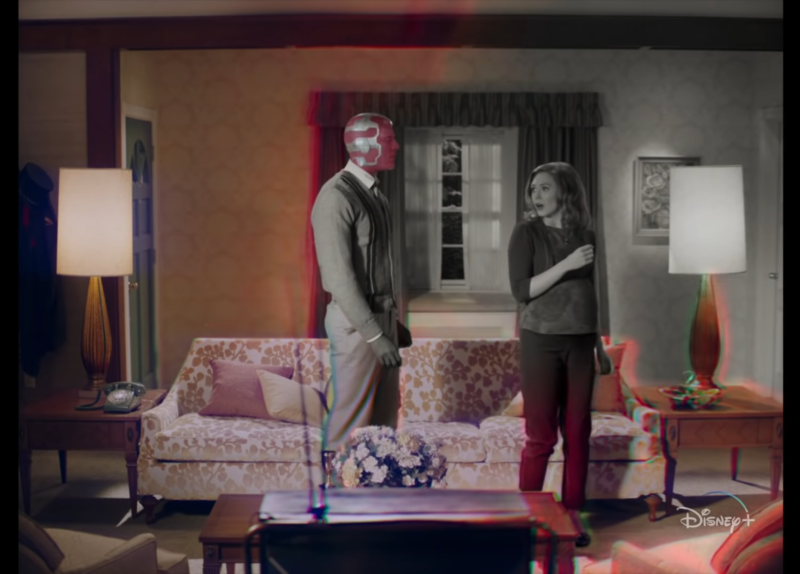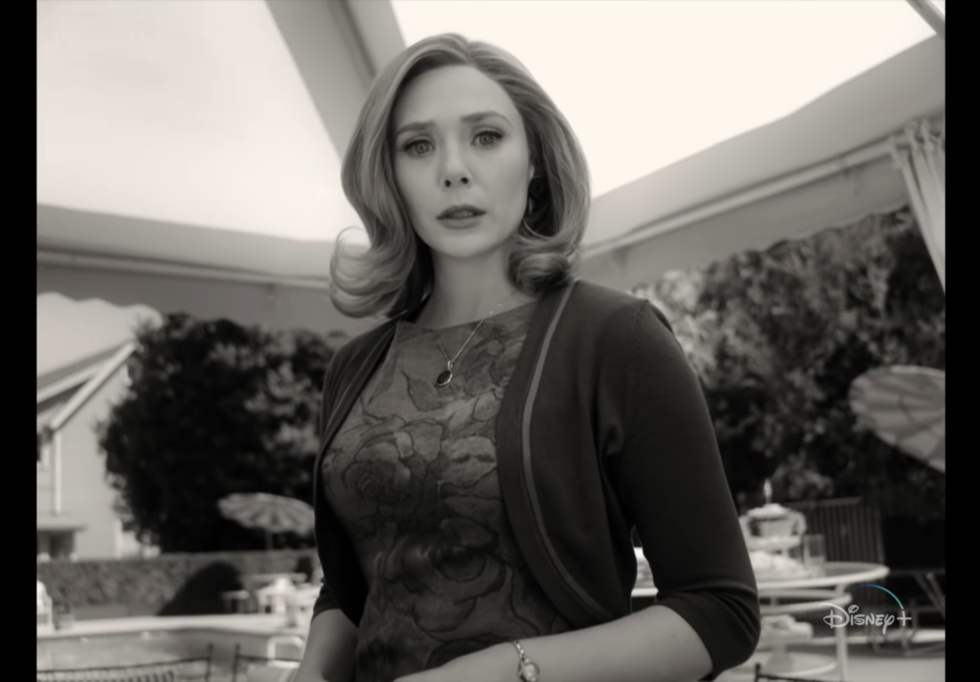
The modern era of Marvel Comics television has been a jumpy one, with ABC and Netflix dividing-and-conquering based on available comic series, exclusivity deals, and otherwise trying not to step on Marvel Studios' gargantuan toes. Fans got some fascinating television out of the process, but those network deals eventually fizzled—perhaps not coincidentally, right around the time that the Disney corporate umbrella began plotting its own content-filled streaming service.
As a result, today's premiere of Wandavision on Disney+ is far from the first TV series with clear links to the Marvel Cinematic Universe. But it's definitely the clearest one yet. Take two major actors from repeat MCU films, slap them into the first-ever TV series that opens with a Marvel Studios logo, and you've got yourself one massive statement of intent.
As if that weren't gutsy enough, Wandavision goes further in terms of ambition with a two-part series premiere that will befuddle fans and outsiders alike. After over a year of squint-worthy reveals, with hints of black-and-white TV throwbacks and superhero-filled intrigue, we have 65 minutes of goofiness, dread, and a sense that this weird series is only going to get weirder.
Doozy me this
Mild spoilers from here on out, based on previously revealed series trailers.
-
Wanda uses her magic to join their beds together. Sorry about that, '60s sitcom sensibilities.
-
Elizabeth Olsen as Wanda.
-
Paul Bettany as Vision.
-
Wanda uses magic to tidy the kitchen.
-
Vision uses magic to disguise his robot face.
-
The chemistry between these two is surprisingly sweet.
-
A magic show—with jokes about how the duo can't use their real powers.
More bluntly, the first 30-minute episode is so odd that it's unsurprising to see Disney+ break its tradition of "one episode a week" and offer the second episode for immediate binging. The first episode commits severely to the series' apparent "twin timeline" gimmick by focusing almost entirely on a seemingly idyllic world, trapped in a late 1950s TV sitcom universe. Every man wears a suit; every woman wears a pointy bra and immaculately coiffed hair; and every scene is bathed in absurdly bright lights, black-and-white filters, and artificial audience laughter.
Even if you haven't followed lead characters Wanda "Scarlet Witch" Maximoff (Elizabeth Olsen) and Vision (Paul Bettany), Wandavision quickly clarifies their otherworldly superpowers—meaning, each I Love Lucy-caliber moment of laugh-tracked slapstick has a healthy superhero dollop. Tidying the kitchen means juggling a series of hovering dishes. A dated reference to demanding food from the wife is interrupted by a reminder that Vision's a robot and can't eat, anyway.
The first episode primarily hints to the series' underlying layer by peppering the cookie-cutter sitcom setup with increasingly nagging questions. Husband and wife see that today's date is marked on the calendar with a heart, and at first, we're led to believe it's funny that they both can't remember why it's there. Anniversary? Special occasion? Wandavision sets a predictable sitcom plot into motion when the couple splits up in making incorrect assumptions about this date, leading to a wacky dinner party where the duo tries to both keep guests comfortable and hide their superpowers. What a doozy!
We get about 20 minutes into the episode before question marks begin piling up, right around the time that the episode's trope-filled '50s throwbacks grow a bit tiresome. Olsen and Bettany's chemistry is the best part about this goofy content, but when they split up for the day, their supporting cast—a dry-as-dirt bunch of office coworkers for Vision, and an absurdly aroused neighbor (Kathryn Hahn) for Wanda—doesn't live up to that spark. Thankfully, the dinner party gets downright weird, as we come to understand that the date on the calendar was the tip of the couple's iceberg. Turns out, they're as confused by this whole 1950s pastiche as we are in the audience.
For which children?

The episode takes a little too long to get everyone onto the same page—and there's enough foreshadowing through the episode to make viewers begin tapping their watches and saying, "Get on with it." But the weirdness cultivates enough of a sense of dread that I, at the very least, was willing to commit—but I do wonder if I'd have felt the same way without a guarantee of a second episode to watch immediately after.
Sure enough, this second episode begins cheerfully toying with the fact that Wanda and Vision appear to exist in two places at once, even though the camera continues focusing only on their black-and-white sitcom selves. We also see an advancement in the series' apparent era, with the following episode looking nearly a decade newer in terms of fashion and video treatment, along with an increasingly clear look at what doesn't quite add up in this idyllic universe.
A fundraiser event prompts the couple's neighbors to say the phrase "for the children" in monotone unison—often enough for us to notice that there aren't any kids around. An inter-office chat peppers dark anti-communist sentiment between playful banter. And a freak radio broadcast includes chatter that seems to be aimed at Wanda, as uttered by whatever man makes a brief cameo at the end of the first episode. That says nothing of the way these first two episodes play around with hints of color, or the fictional commercials that shamelessly tie the series into the larger MCU.
All of this is, once again, stitched together by Olsen and Bettany driving the series with a goofy, adorable chemistry that they would otherwise never get to show off in Marvel Studios films. At the same time, the duo still carves out their own humorous space with superpower sight gags usually relegated to the dustbin of '80s sitcom history (e.g. Small Wonder, Out of this World). Without this duo in the driver's seat, quite frankly, I may not have been eager to recommend the 65 minutes on Disney+ thus far. The show is otherwise an exercise in feeding MCU teases and mysteries, while building an entirely new plotline that seems to borrow from similar Scarlet Witch comics stories (with a few distinct differences thus far, arguably to fit into whatever film follows this series).
Big ups to the House of Mouse
But I also can't help but enjoy how outright dark and weird the series gets in those moments when the first two episodes' shimmering, superficial layer starts to crack, revealing a pulsing, disturbing belly beneath. Marvel Studios is clearly cashing in on the combined factors of viewer goodwill, buoyed by millions of Avengers film fans coming in with allegiance and understanding, and the fact that viewers aren't stumbling onto this show in episodic, network-TV fashion. I imagine a confused comics outsider tuning in to the first episode 22 minutes in, when a man begins choking on his dinner while his wife begins berating him in a cold, almost David Lynch-ian manner, and immediately shouting, "There's something wrong with the TV!" while changing the channel to Wheel of Fortune.
For that, I applaud the House of Mouse for putting this oddball series front and center on Disney+, guaranteeing to confuse at least a few hundred thousand viewers while delivering a slow-burn story of what the heck has happened to Scarlet Witch and Vision since (or, uh, during?) the events of Avengers: Endgame. It's another example of Disney making the most of a captive streaming audience and taking existing properties to strange new places instead of trying to please everyone with every big-ticket character in a film's two-hour runtime. (Or, as of late, more like 2.5 hours.) Best of all, this two-part premiere isn't really demanding. Go on, put the episodes on while checking your phone or making a meal. You can always pause and rewind when a glaring red-and-yellow object appears in the otherwise black-and-white frame.
reader comments
180